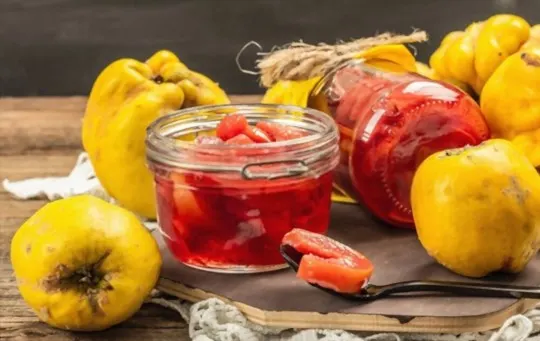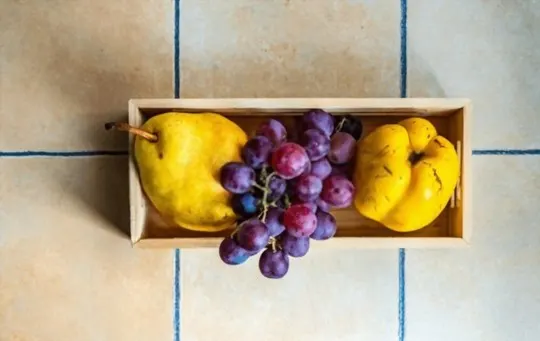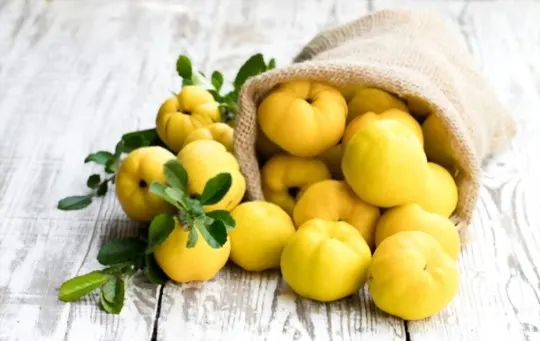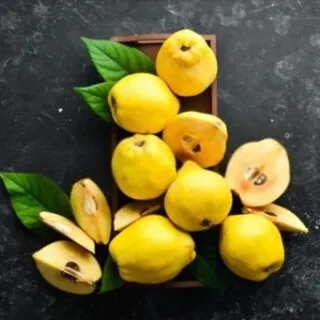Have you ever heard of a quince and wondered what it tastes like? You’re not alone.
This article provides everything you need to know about the mysterious, yet delicious, quince.
From how to pick one, to how to enjoy it in recipes – get ready to explore the unique flavors of this distinctive fruit.
What is a Quince?

A quince is a fruit that is closely related to apples and pears, with a unique flavor and texture that sets it apart from other fruits.
The taste of a quince is best described as a sour, tangy, and astringent combination of apple, pear, and lemon.
When cooked, quinces develop a sweet and floral flavor that pairs well with sugar, honey, or cinnamon.
Quinces are also known for their grainy texture, which disappears when they are cooked, releasing a natural pectin that makes them ideal for making jams, jellies, and sauces.
Here are some interesting facts about quinces:
- Quinces are high in fiber, vitamin C, and antioxidants.
- Quinces can be eaten raw but are most commonly cooked or made into preserves.
- Quince trees are easy to grow and require minimal maintenance.
If you’re looking for a unique and flavorful fruit to add to your diet or use in your cooking, give quince a try.
What Does a Quince Taste Like?

Quince is a fruit with a unique taste that is often compared to a combination of apple, pear, and citrus flavors.
It has a tart and astringent taste when eaten raw but transforms into a sweet and delicious flavor when cooked.
Here are some ways to describe the taste of quince:
- Tart and astringent like a lemon, especially when unripe.
- Fragrant and floral, like the scent of roses or guava.
- Sweet and rich, like a blend of apples, pears, and honey.
- Tangy with a hint of spiciness or cinnamon flavor.
To bring out the best flavor of quince, it is often cooked before being consumed.
Some popular ways to cook quince include making jams, jellies, and compotes, baking in pies or tarts, roasting with savory dishes, or even fermenting to make quince wine.
When cooking quince, make sure to remove the tough outer skin and seeds, which are inedible.
Boiling quince in water infused with cinnamon and sugar can help make the taste more pleasant.
Factors that Affect the Taste of Quince

Quinces are a unique fruit with a complex and savory taste profile that’s hard to describe.
The flavor of quinces is affected by several factors, including their ripeness, cooking method, and the presence of tannins and pectins.
Here are some of the factors that affect the taste of quince:
- Ripeness: Quinces are often picked when they’re still hard and unripe. As they ripen, the quince flesh softens, and its flavor becomes sweeter and more complex.
- Cooking method: Quinces can be cooked in various ways, such as stewed, roasted, or baked. Depending on the method used, the fruit can have a tangy, slightly sour taste or a caramelized, honey-like flavor.
- Pectins and tannins: Quinces contain high levels of pectins and tannins, which give them a unique flavor and texture. Pectins give the fruit a slightly tart taste and a thick, gooey texture when cooked. Tannins are responsible for the fruit’s astringent taste, which can make them less appealing to eat raw.
These factors all come together to give quinces their distinct flavor.
Their unique sweetness, tartness, and savory undertones make them a versatile ingredient in various dishes, from sweets to savory dishes.
When cooking with quinces, try adding a bit of sugar or honey to balance out their tartness and highlight their natural sweetness.
1 – Ripeness
Ripeness is crucial when it comes to enjoying the unique flavor of a quince.
These fruits are not meant to be eaten raw, and their taste can vary significantly depending on their ripeness.
When fully ripe, quinces have a sweet aroma and a taste that is often compared to a combination of apples and pears, with a slight citrus tang.
The texture of ripe quince is soft and grainy, making it ideal for use in jams, jellies, and other cooked recipes.
On the other hand, unripe quinces can have a sour and astringent taste, which makes them unpalatable to eat.
However, unripe quince is still good for use in making jams and jellies, as the high levels of pectin in their undeveloped seeds and skin can help the mixture to gel properly.
It is best to wait until after the first frost before harvesting quinces, as cooler temperatures can help to develop their flavor and fragrance.
When selecting quinces, choose fruit that is golden-yellow in color and feels slightly soft when pressed.
They can be stored in a cool and dry place for up to a month.
Quince is an excellent source of dietary fiber, vitamin C, and antioxidants.
So, try to include it in your diet for its health benefits.
2 – Cooking Method
Quince has a unique flavor profile that varies depending on how it’s prepared.
When raw, it’s tough, sour, and almost inedible.
But once it’s cooked, quince transforms into a delicious fruit with a flavor reminiscent of apples, pears, and citrus with a floral aroma.
Here are two popular cooking methods for quince:
- Baking: Quince can be baked into pies, tarts or roasted with honey, and cinnamon for a decadent dessert. Baking helps break down the quince’s tough fibers and releases its flavors.
- Boiling: Quince can be boiled to make a syrup, marmalade or jelly, and fruit cheese. Boiling helps bring out the fruit’s natural sweetness and aroma.
- Fun fact: Quince paste is a traditional Spanish delicacy typically served with cheese or crackers.
How to Cook Quince to Enhance its Flavor?

Quince is a unique fruit with a tart, sour taste and a tough, gritty texture.
However, cooking quince can enhance its flavor and make it more palatable.
Here’s how you can cook quince to bring out its best flavors:
- Poaching – Simmer sliced quince in a sugar syrup with spices like cinnamon or ginger until it becomes tender and translucent.
- Roasting – Cut quince into quarters, drizzle with honey, and roast at 375°F until golden brown and caramelized.
- Baking – Peel and core quince, then layer it in a baking dish with sugar and butter before baking until soft and golden brown.
Once cooked, the flavor of quince transforms into a lusciously floral, musky and slightly nutty taste, depending on the cooking technique used.
You can use cooked quince in a variety of dishes, including tarts, pies, jams, jellies, sauces, and even savory dishes like meat stews or roasted vegetables.
Try experimenting with different cooking styles to find your favorite take on this under-appreciated fruit.
Nutritional Value of Quince
Quince is a highly nutritious fruit that is packed with vitamins, minerals, and other essential nutrients.
Its flavor is quite unique and difficult to describe, as it is somewhere between an apple and a pear, with a floral and slightly tart taste.
Here is the nutritional value of Quince per 100 grams:
- Calories – 57.
- Carbohydrate – 15 grams.
- Fiber – 1.9 grams.
- Protein – 0.4 grams.
- Fat – 0.1 grams.
- Vitamin C – 15.0 mg (16% DV*).
- Vitamin E – 0.1 mg (1% DV).
- Potassium – 197 mg (4% DV).
- Iron – 0.7 mg (4% DV).
- Magnesium – 8 mg (2% DV).
Quince also contains small amounts of calcium, phosphorus, zinc, and vitamin K.
Its high fiber content makes it excellent for digestion and gut health.
Quince’s flavor and texture make it perfect for use in jams, preserves, sauces, and baked goods.
Culinary Uses of Quince

Quinces are a unique fruit with a flavor that is a combination of various fruits, and the texture of the fruit changes when it is cooked.
Its culinary uses are diverse and exciting, making it a versatile ingredient in numerous dishes.
The taste of a quince is hard to describe as it has a mix of flavors, which is why people often compare it to other fruits.
It is tart and acidic like a lemon, and some people also feel a slight apple-like sweetness that is hidden beneath its sour taste.
The flavor of a quince changes when it is cooked and assumes a deep reddish hue and has a unique aroma.
The fruit can be used in both savory and sweet dishes.
Culinary Uses of Quince:
- Jams, jellies, and preserves: The fruit pulp can be used to make delectable jams and preserves due to its high natural pectin content.
- Stews and curries: It can be used as a meat flavoring ingredient in stews or curries to add a subtle, fruity flavor.
- Beverages: Quince can be used to make tea or juice, which is a refreshing drink.
- Baked goods: A popular Persian dessert called “Shirin Polow” uses saffron rice, caramelized onions, orange peel, and sliced quince topped with pistachios and almonds to make a sweet, delicious dessert.
When shopping for quinces, select the ones that are fragrant, but not too soft-ripe.
They should feel hard and firm to the touch.
Where to Buy Quince and How to Store It
Quince has a unique and complex flavor that is often described as a mix of apple, pear, and guava, with hints of floral and spicy notes.
To enjoy this fruit, it’s essential to know where to buy it and how to store it properly.
Here are some tips on where to find quince and how to store it:
Where to Buy Quince:
- Farmer’s markets: Look for farmer’s markets in your area that specialize in selling fresh produce. You can find quince during the peak season, from September to December.
- Specialty stores: Visit specialty stores that sell exotic or international fruits. They may have quince in stock during the year.
- Online: You can also buy quince online from various suppliers who source quince from different parts of the world.
How to Store Quince:
- Refrigerate: Store quince in the refrigerator for up to 2 weeks.
- Room temperature: If you plan to use the quince soon, keep it at room temperature for a few days.
- Freeze: You can also freeze quince for up to 6 months. Store it in an airtight container or freezer bag.
Follow these tips and enjoy the unique and delicious taste of quince in different recipes, such as jams, jellies, pies, or roasted meat dishes.
Pro tip: Quince is a great source of dietary fiber, vitamin C, and antioxidants.
Its seeds and leaves can also be used to make tea, which has many health benefits.
Conclusion
In conclusion, a quince has a unique flavor profile that combines tartness with sweetness, giving the fruit a distinctive taste that cannot be compared to any other fruit.
Quinces have a hard and dense texture that softens with cooking, making them ideal for culinary use in jams, jellies, and desserts.
When raw, quinces are too hard and sour to be eaten, and cooking them is necessary to bring out their sweetness and flavor.
Quinces also have several health benefits, including high levels of fiber, vitamin C, and antioxidants.
If you’re looking to add a new and interesting flavor to your culinary repertoire, give quinces a try, and you won’t regret it.

What Does a Quince Taste Like? A Comprehensive Guide
Ingredients
- Quince
- Ingredients from your selected recipes
Instructions
- Select your favorite ingredient from the range available in this article.
- Collect all the necessary items to make the recipe.
- Use the instructions provided to prepare a delicious dish in 30 minutes or less.

Carrie is a food writer and editor with more than 15 years of experience. She has worked for some of the biggest names in the food industry, including Bon Appétit, Food & Wine, and Martha Stewart Living.
As the Editor in Chief of IntroChicago.com, Carrie oversees all of the content on the site. She also manages the team of contributing writers and editors, who help to create delicious recipes, helpful tips, and informative articles that you’ll find on the site.
A native of the Chicago area, Carrie is passionate about all things food. She loves trying new restaurants and experimenting with new recipes in her kitchen. She’s also a graduate of the Culinary Institute of America, so she knows a thing or two about food!
